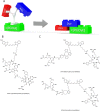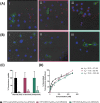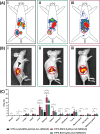Click Chemistry in the Design and Production of Hybrid Tracers
- PMID: 31460363
- PMCID: PMC6682143
- DOI: 10.1021/acsomega.9b01484
Click Chemistry in the Design and Production of Hybrid Tracers
Abstract
Hybrid tracers containing both fluorescent and radioactive imaging labels have demonstrated clinical potential during sentinel lymph node procedures. To combine these two labels on a single targeting vector that allows tumor-targeted imaging, end-labeling strategies are often applied. For αvβ3-integrin-targeting hybrid tracers, providing an excellent model for evaluating tracer development strategies, end-labeling-based synthesis provides a rather cumbersome synthesis strategy. Hence, the aim of this study was to investigate the use of heterobifunctional cyanine dyes in a click-chemistry-based synthesis strategy for RGD-based hybrid tracers. The triazole-based hybrid tracers DTPA.DBCO.N 3 (SO 3 )-Cy5-c[RGDyK] and DTPA.BCN.N 3 (SO 3 )-Cy5-c[RGDyK] were obtained in fewer steps than DTPA-Lys(Cy5(SO 3 )methyl)-Cys-c[RGDyK] and had partition coefficients of log P (o/w) = -2.55 ± 0.10, -1.45 ± 0.03, and -2.67 ± 0.12, respectively. Both tracers were chemically stable, and the brightnesses of DTPA.DBCO.N 3 (SO 3 )-Cy5-c[RGDyK] and DTPA.BCN.N 3 (SO 3 )-Cy5-c[RGDyK] were, respectively, 23 × 103 and 40 × 103 M-1 cm-1; lower than that of the reference tracer DTPA-Lys(Cy5(SO 3 )methyl)-Cys-c[RGDyK] (50 × 103 M-1 cm-1). Assessment of serum protein binding revealed no statistically significant difference (44 ± 2 and 40 ± 2% bound for DTPA.DBCO.N 3 (SO 3 )-Cy5-c[RGDyK] and DTPA.BCN.N 3 (SO 3 )-Cy5-c[RGDyK], respectively; 36 ± 5% bound for DTPA-Lys(Cy5(SO 3 )methyl)-Cys-c[RGDyK]; p > 0.05). DTPA.DBCO.N 3 (SO 3 )-Cy5-c[RGDyK] (K D = 17.5 ± 6.0) had a statistically significantly higher affinity than the reference compound DTPA-Lys(Cy5(SO 3 )methyl)-Cys-c[RGDyK] (K D = 30.3 ± 5.7; p < 0.0001), but DTPA.BCN.N 3 (SO 3 )-Cy5-c[RGDyK] had a statistically significantly lower affinity (K D = 76.5 ± 18.3 nM; p < 0.0001). Both [ 111 In]DTPA.DBCO.N 3 (SO 3 )-Cy5-c[RGDyK] and [ 111 In]DTPA.BCN.N 3 (SO 3 )-Cy5-c[RGDyK] enabled in vivo visualization of the 4T1 tumor via fluorescence and single-photon emission computed tomography (SPECT) imaging. Biodistribution data (% ID/g) revealed a significant increase in nonspecific uptake in the kidney, liver, and muscle for both [ 111 In]DTPA.DBCO.N 3 (SO 3 )-Cy5-c[RGDyK] and [ 111 In]DTPA.BCN.N 3 (SO 3 )-Cy5-c[RGDyK]. As a result of the higher background activity, the tumor-to-background ratio of the click-labeled RGD analogues was twofold lower compared to the end-labeled reference compound. The use of click chemistry labeling did not yield a pronounced negative effect on serum protein binding, in vitro stability, and receptor affinity; and tumors could still be visualized using SPECT and fluorescence imaging. However, quantitative in vivo biodistribution data suggest that the triazole and strained cyclooctyne moieties associated with this type of click chemistry negatively influence the pharmacokinetics of RGD peptides. Nevertheless, the design might still hold promise for other targets/targeting moieties.
Conflict of interest statement
The authors declare no competing financial interest.
Figures




Similar articles
-
Tracers for Fluorescence-Guided Surgery: How Elongation of the Polymethine Chain in Cyanine Dyes Alters the Pharmacokinetics of a Dual-Modality c[RGDyK] Tracer.J Nucl Med. 2018 Jun;59(6):986-992. doi: 10.2967/jnumed.117.205575. Epub 2018 Feb 15. J Nucl Med. 2018. PMID: 29449447
-
Interventional nuclear medicine: "click" chemistry as an in vivo targeting strategy for imaging microspheres and bacteria.Biomater Sci. 2021 Mar 10;9(5):1683-1690. doi: 10.1039/d0bm01823f. Biomater Sci. 2021. PMID: 33410436
-
Pegylated Arg-Gly-Asp peptide: 64Cu labeling and PET imaging of brain tumor alphavbeta3-integrin expression.J Nucl Med. 2004 Oct;45(10):1776-83. J Nucl Med. 2004. PMID: 15471848
-
64Cu-Labeled Phosphonate Cross-Bridged Chelator Conjugates of c(RGDyK) for PET/CT Imaging of Osteolytic Bone Metastases.Cancer Biother Radiopharm. 2018 Mar;33(2):74-83. doi: 10.1089/cbr.2017.2419. Cancer Biother Radiopharm. 2018. PMID: 29634417 Free PMC article.
-
Hybrid Imaging Labels: Providing the Link Between Mass Spectrometry-Based Molecular Pathology and Theranostics.Theranostics. 2017 Jan 12;7(3):624-633. doi: 10.7150/thno.17484. eCollection 2017. Theranostics. 2017. PMID: 28255355 Free PMC article.
Cited by
-
Hybrid Tracers Based on Cyanine Backbones Targeting Prostate-Specific Membrane Antigen: Tuning Pharmacokinetic Properties and Exploring Dye-Protein Interaction.J Nucl Med. 2020 Feb;61(2):234-241. doi: 10.2967/jnumed.119.233064. Epub 2019 Sep 3. J Nucl Med. 2020. PMID: 31481575 Free PMC article.
-
A Modular Approach for the Synthesis of Diverse Heterobifunctional Cyanine Dyes.J Org Chem. 2024 Mar 15;89(6):3844-3856. doi: 10.1021/acs.joc.3c02673. Epub 2024 Feb 27. J Org Chem. 2024. PMID: 38413005 Free PMC article.
-
The helminth glycoprotein omega-1 improves metabolic homeostasis in obese mice through type 2 immunity-independent inhibition of food intake.FASEB J. 2021 Feb;35(2):e21331. doi: 10.1096/fj.202001973R. FASEB J. 2021. PMID: 33476078 Free PMC article.
-
Click Chemistry and Radiochemistry: An Update.Bioconjug Chem. 2023 Nov 15;34(11):1925-1950. doi: 10.1021/acs.bioconjchem.3c00286. Epub 2023 Sep 22. Bioconjug Chem. 2023. PMID: 37737084 Free PMC article. Review.
-
Strain-Promoted Azide-Alkyne Cycloaddition-Based PSMA-Targeting Ligands for Multimodal Intraoperative Tumor Detection of Prostate Cancer.Bioconjug Chem. 2022 Jan 19;33(1):194-205. doi: 10.1021/acs.bioconjchem.1c00537. Epub 2021 Dec 25. Bioconjug Chem. 2022. PMID: 34957825 Free PMC article.
References
-
- Bakkum T.; van Leeuwen T.; Sarris A. J. C.; van Elsland D. M.; Poulcharidis D.; Overkleeft H. S.; van Kasteren S. I. Quantification of Bioorthogonal Stability in Immune Phagocytes Using Flow Cytometry Reveals Rapid Degradation of Strained Alkynes. ACS Chem. Biol. 2018, 13, 1173–1179. 10.1021/acschembio.8b00355. - DOI - PMC - PubMed
-
- Burggraaf J.; Kamerling I. M.; Gordon P. B.; Schrier L.; de Kam M. L.; Kales A. J.; Bendiksen R.; Indrevoll B.; Bjerke R. M.; Moestue S. A.; Yazdanfar S.; Langers A. M.; Swaerd-Nordmo M.; Torheim G.; Warren M. V.; Morreau H.; Voorneveld P. W.; Buckle T.; van Leeuwen F. W.; Odegardstuen L. I.; Dalsgaard G. T.; Healey A.; Hardwick J. C. Detection of colorectal polyps in humans using an intravenously administered fluorescent peptide targeted against c-Met. Nat. Med. 2015, 21, 955–961. 10.1038/nm.3641. - DOI - PubMed
-
- Sturm M. B.; Joshi B. P.; Lu S.; Piraka C.; Khondee S.; Elmunzer B. J.; Kwon R. S.; Beer D. G.; Appelman H. D.; Turgeon D. K.; Wang T. D. Targeted imaging of esophageal neoplasia with a fluorescently labeled peptide: first-in-human results. Sci. Transl. Med. 2013, 5, 184ra6110.1126/scitranslmed.3004733. - DOI - PMC - PubMed
LinkOut - more resources
Full Text Sources
Other Literature Sources
Research Materials
